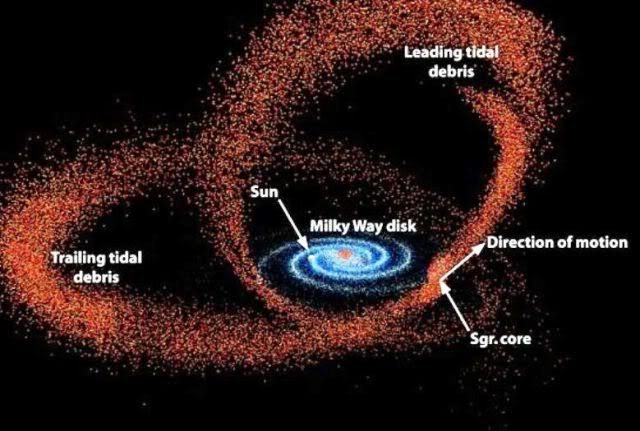I want to take a break from talking about star clusters today to discuss something on a much larger scale: our galaxy! This is motivated by a visit yesterday from Dr Vasily Belokurov from Cambridge University who gave an excellent seminar on the size and structure of our galaxy from studies of how our galaxy grows.
Large galaxies like our Milky Way galaxy can grow by absorbing smaller dwarf galaxies. These dwarf galaxies are common in the Universe and when they get close to a massive galaxy like ours they are drawn towards it by gravity and begin to orbit the larger galaxy (they're often called satellite galaxies at this point).
When these small galaxies get really close to the large galaxy they begin to be disrupted by the gravitational force from the larger galaxy and can actually be torn to shreds, scattering the stars in the dwarf galaxy out into long tidal streams, as shown in the image below.
 |
| Tidal streams caused by orbiting satellite galaxies (Credit: David Law) |
This process can take millions of years while the dwarf galaxy orbits and falls into the larger galaxy. This creates patterns of huge tidal streams emanating from these satellite dwarf galaxies and which encircle our own galaxy.
A famous example of this is the Sagittarius dwarf galaxy, which is about 82,000 light years from us and in the process of being stripped apart as it orbits the Milky Way. We can see this as a huge stream of stars that circles the sky known as the Sagittarius tidal stream. The image below shows this stream (and other streams) using data from the Sloan Digital Sky Survey - which we talked about in a previous post. The Milky Way will one day consume this galaxy entirely, absorbing all of its stars into the halo of our galaxy.
 |
| The Sagittarius Tidal Stream as seen in SDSS data (Credit: Vasily Belokurov) |
Dr Belokurov studies tidal stream such as this to infer the large-scale structure of our galaxy. Because we are inside our galaxy it can be hard to determine it's full size and spatial extent, so this can be difficult work. This approach is kind of like inferring the structure of a city by tracing the motions of cars entering the city - even if you don't know where the buildings and places of interest are, you would be able to estimate where they are and how the city is structured by the motions of cars into and around the city. This is exactly what Dr Belokurov does, only by using the positions and motions of tidal streams he can infer the structure of the galaxy!
No comments:
Post a Comment